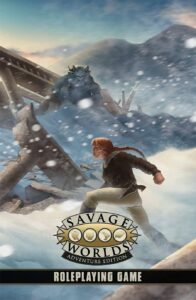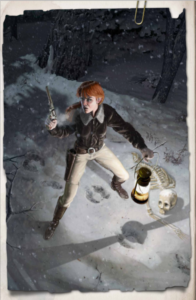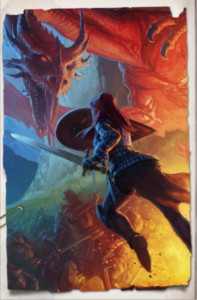
Savage Worlds Adventure Edition (SWADE) was designed and written by Shane Lacy Hensley with Clint Black, and published by Pinnacle Entertainment Group in 2023. It’s a generic rules system of cinematic action with a historied pedigree and an amazing range of sourcebooks, but how does it fare against more rules-y games like GURPS or narrativist darlings like FATE? We take it apart to see what keeps its motor running mechanically and stylistically, then put it back together to discuss how that affects play.
As noted at the end of the episode, Greg and James were given PDF copies of the game by PEG and we are properly grateful for that but it did not affect our objectivity.
Click here to see Savage Worlds: Adventure Edition on DriveThruRPG
This episode was made possible by the support of our Kickstarter backers and in particular Max Nestorowich. Check out Max’s actual-play podcast Relatable Rolls here.
Greg: ‘Oh James, you’re no fun’
James: ‘I’m absolutely not.’
Show Notes
The episode is presented as always by Ross Payton, Greg Stolze and James Wallis. Editing by Ross Payton, shownotes compiled by James Wallis, helpless laugher about half-way through from Greg Stolze.
Savage Worlds was first published in 2003, adapted from systems and mechanics devised for PEG’s Deadlands RPG and specifically from Deadlands: the Great Rail Wars (1997). There are sourcebooks available for playing Deadlands using the Savage Worlds rules, or you can still buy the excellent standalone RPG.
Savage Rifts, the version of the game that Ross is running a campaign of, is a Savage Worlds adaptation of the popular Rifts universe originally created by Kevin Siembieda and published by Palladium Books, using the SR mechanics. The line has been hugely successful, with over sixty products released for it.
Reign is Greg’s highly regarded RPG of leadership and power in fantasy realms. For obvious reasons it’s a strong recommend.
The Palladium roleplaying system dates back to the release of Palladium Fantasy in 1983. With customary dryness Wikipedia observes that ‘Some critics noted that this game, created only a few years after Advanced Dungeons & Dragons, has many similarities.’ Designed by Kevin Siembieda, it feels dated but it is not without its fans; its mechanics form the heart of the company’s later games including Rifts. James wrote two books for Palladium in the 1990s: he has a good word for the company but it’s not printable
William Hope Hodgson was one of the leading weird-fantasy authors of the early 1900s, and also a bodybuilder and self-defence tutor. The House on the Borderlands is one of his most notable works, alongside his amazing pecs. ‘The Derelict’ is the story that Greg refers to in the episode, and it’s a banger. Lovecraft was a big Hope Hodgson fan.
The Mouse That Roared is a 1959 movie about a tiny central European country, Grand Fenwick, that accidentally becomes a nuclear power, and stars Peter Sellars in several roles. That is not what Greg was referring to when he used the term but I thought I’d mention it anyway because it comes in the middle of the long bit about mechanics and probability and I was getting bored. It’s a fun movie, based on an equally fun book, and features a brief appearance by a board game called Diplomacy – though not Allan Calhamer’s classic, which was released the same year. The follow-up, The Mouse on the Moon, isn’t as good.
GURPS is Steve Jackson Games’s Generic Universal Roleplaying System, originally released in 1986 and now on its fourth edition. Absolutely solid set of rules that can fit with almost any genre if you push a bit, but these days the game line is mostly noted for its excellent range of sourcebooks.
FATE is another generic RPG system, this one of a more narrativist ilk, designed by Leonard Balsera, Fred Hicks and Rob Donoghue, first published in 2003 by Evil Hat Productions, and also now on its fourth edition. It is based on the FUDGEsystem designed by Steffan O’Sullivan in 1992 (in fact FATE stands for ‘FUDGE Adventures in Tabletop Entertainment’): the 1995 edition of FUDGE is still available as a free download but the more modern version is a commercial release. No snark, please: designers need to eat too.
GNS Theory, standing for ‘Gamist-Narrativist-Simulationist’, is one of the keystones of RPG design theory. It arose in online discussions in the late 1990s and, championed by Ron Edwards, went on to underlie a lot of the discussion in the Forge online game-design community in the mid-2000s. Since superseded by more critical thinking about games and their design intent, it is still a useful shorthand for describing styles of game mechanics and play.
Delicious in Dungeon is an anime series on Netflix, in which a party of adventurers explore a massive complex dungeon to find and resurrect a lost member of their group, and begin to supplement their meagre supplies by cooking and eating the monsters they have killed. It is charming, clever and funny.
World of Synnibarr is a much-derided old-school fantasy/SF hybrid roleplaying game by Raven C. S. McCracken. On its third edition, it still has fans.
TSYK by Serge Stelmach is an RPG that nobody in the world remembers except for Greg, Serge and just possibly you. Please, we need to find a copy of this and put it back out there. Greg says it does clever things with fate points as a meta-currency to direct the narrative of future sessions; but it had me at ‘time-travelling dinosaurs’.
Noble Knight is probably the best source in the world for second-hand tabletop games, specifically RPG materials, often very obscure ones. They have a huge store in Wisconsin, they ship worldwide, they are a pleasure to deal with, and they have been known to sponsor podcasts HINT HINT
Lancer is a tactical RPG about giant robots that we talked about back in the mists of time (series 1 episode 3).
I’ve talked too much about the reboot of the Paranoia RPG (2017) by James Wallis, Grant Howitt and Paul Dean but here’s another link to it. I don’t get royalties on it, I swear, I just think we did some interesting things with the design and I’d like to draw your attention to it.
Greg alludes to a game about big money and erotic ambiguity without naming it: the RPG he is too modest to name is his own Million Dollar Soulmate, which you should check out.
After much discussion on the LND Discord we narrowed down the card game Greg meant when he said ‘Desolation’, and it’s Desperation, an award-winning narrative game of survival horror by the gifted creator of Fiasco (which we looked at in season 2 episode 14) Jason Morningstar. But Gloom is Keith Baker’s excellent, humorous and very gothic game of wiping out family bloodlines with transparent cards, and if you haven’t played it you should.
The One Roll Engine is Greg’s renowned d10-based dice-pool system, that has you looking for matching results to create ‘width’ (the number of matching dice) and ‘height’ (the number on the dice). The system first appeared in Godlike, and was later used in Wild Talents, A Dirty World, Reign, and Monsters and Other Childish Things.
When we discuss the interior artwork of Savage Worlds, these are two of the good images we talk about, but we will save you from the polar bear. All copyright remains with the rights holder and all that.


And finally, to answer the argument about who used the word ‘smörgåsbord’ first in this episode, James did, at 49:21.
If you enjoyed this episode, check out the discussion on our Discord.
If you click on any of the above links to DriveThruRPG and buy something, Ludonarrative Dissidents will receive a small percentage of the purchase price. You will not be charged more, and the game’s publisher will not receive less, it’s a win-win-win. Thank you for supporting the podcast this way.